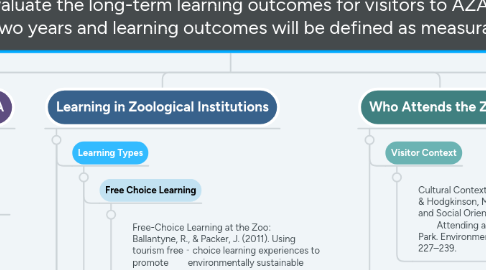
1. What is a "Zoo"- AZA vs Non AZA
1.1. Association of Zoos and Aquariums
1.1.1. AZA Report: Annual Report on Conservation and Science
1.2. Modern Zoos
1.2.1. Modern Zoo: Baratay, Eric and Hardouin-Fugier, E. (2004). Zoo: A History of Zoological Gardens in the West. Reakiton Books.
1.3. Zoo Purpose, Mission, & Futures
1.3.1. Mission Statements: Patrick, B. P. G., Matthews, C. E., Ayers, D. F., & Tunnicliffe, S. D. (2007). Conservation and Education: Prominent Themes in Zoo Mission Statements. Journal of Environmental Education, 38(3), 53–60.
1.3.2. Zoo Futures: Cohen, J. (2013). Zoo futures. Conserv Magazine, 14, 16-25.
1.3.3. Zoo Institutional Identity: Hyson, J. (2004). Education, entertainment, and institutional identity at the zoo. Curator: The Museum Journal, 47(3), 247-251.
1.3.4. Purpose of Zoos: Conway, W. G. (2011). Buying time for wild animals with zoos. Zoo Biology, 30(1), 1-8.
2. Learning in Zoological Institutions
2.1. Learning Types
2.1.1. Free Choice Learning
2.1.1.1. Free-Choice Learning at the Zoo: Ballantyne, R., & Packer, J. (2011). Using tourism free‐choice learning experiences to promote environmentally sustainable behaviour: the role of post‐visit “action resources.” Environmental Education Research, 17(2), 201–215. doi:10.1080/13504622.2010.530645
2.1.2. Adult Learning
2.1.2.1. Adult Learning in Zoos: Balmford, A., Leder-Williams, N., Mace, G. M., Manica, A., Walter, O., West, C., & Zimmermann, A. (2007). Message Recieved? Quantifying the impact of informal conservation education on adults visiting UK zoos. Conservation Biology Series, 15.
2.2. Biodiversity Literacy in Zoo Visitors
2.2.1. Biodiversity Literacy in Zoo Visitors: Moss, A., Jensen, E., & Gusset, M. (2014). A global evaluation of biodiversity literacy in zoo and aquarium visitors. World Association of Zoos and Aquariums.
2.3. Zoo & Aquarium Impact
2.3.1. Zoo & Aquarium Impact: Falk, J. H., Ph, D., Reinhard, E. M., Vernon, C. L., Bronnenkant, K., & Deans, N. L. (2007). Why Zoos & Aquariums Matter : Assessing the Impact of a Visit to a Zoo or Aquarium. Association of Zoos Aquariums, 24(0205843), 1–24.
2.4. Zoo Education Future
2.4.1. Future of Zoo Education: Moss, A., & Esson, M. (2013). The educational claims of zoos: where do we go from here? Zoo biology, 32(1), 13–8. \
2.5. Learning Outcomes
2.5.1. Critical Look- Visitor Outcomes
2.5.1.1. Critical Look- Visitor Outcomes: Malamud, R., Marino, L., Nobis, N., Broglio, R., & Lilienfeld, S. O. (2010). Do Zoos and Aquariums Promote Attitude Change in Visitors? A Critical Evaluation of the American Zoo and Aquarium Study. Society & Animals, 18(2), 126–138.
2.5.1.2. Critique of Above
2.5.1.2.1. Critique of Above: Vernon, C. L., Bronnenkant, K., Heimlich, J. E., & Falk, J. H. (2010). Critique of a Critique: Do Zoos and Aquariums Promote Attitude Change in Visitors? Society & Animals, 18(4), 415–419
3. Measuring Informal Learning Outcomes
3.1. What is Informal Learning?
3.1.1. Informal Learning: Halliday-Wynes, S., & Beddie, F. (2009). Informal Learning. At a Glance. National Centre for Vocational Education Research Ltd. PO Box 8288, Stational Arcade, Adelaide, SA 5000, Australia.
3.1.2. Informal Learning- Scaffolding
3.1.2.1. Informal Learning- Scaffolding: Yoon, S. A., Elinich, K., Wang, J., Van Schooneveld, J. B., & Anderson, E. (2013). Scaffolding informal learning in science museums: How much is too much?. Science Education, 97(6), 848-877.
3.2. Formal vs Informal Learning
3.2.1. Formal vs Informal Learning: Hofstein, A., & Rosenfeld, S. (1996). Bridging the gap between formal and informal science learning.
3.3. Efficacy of Informal Learning
3.3.1. Informal Learning Efficacy: Mattox, J. R. (2012). Measuring the effectiveness of informal learning methodologies. Development and Learning in Organizations: An International Journal, 26(4).
3.3.2. Museum Learning Outcomes
3.3.2.1. Museum Learning: Hooper‐Greenhill, E. (2004). Measuring learning outcomes in museums, archives and libraries: The Learning Impact Research Project (LIRP). International Journal of Heritage Studies, 10(2), 151-174.
4. Who Attends the Zoo?
4.1. Visitor Context
4.1.1. Cultural Context of Visitors: Morgan, J. M., & Hodgkinson, M. (1999). The Motivation and Social Orientation of Visitors Attending a Contemporary Zoological Park. Environment and Behavior, 31(2), 227–239.
4.2. Urban Zoo-Values
4.2.1. Urban Zoo: Wirtz PH. (1997). Zoo city: Bourgeois values and scientific culture in the industrial landscape. Journal of Urban Design 2: 61-82.
5. Learning Theory
5.1. Experiential
5.1.1. Guests will gain and retain scientific knowledge by experiencing the zoo, reflecting upon their visit, conceptualizing knowledge learned in their personal, real world context, and 'testing' what they've learned against what they already know to be true.
6. Paradigm and Model
6.1. Paradigm
6.1.1. Zoological parks maintain "education" among the top three reasons for their existence.
6.2. Model
6.2.1. Education models/modes at zoological institutions include signage at exhibits, randomized & sporadic exhibit talks, educational shows & planned encounters.

